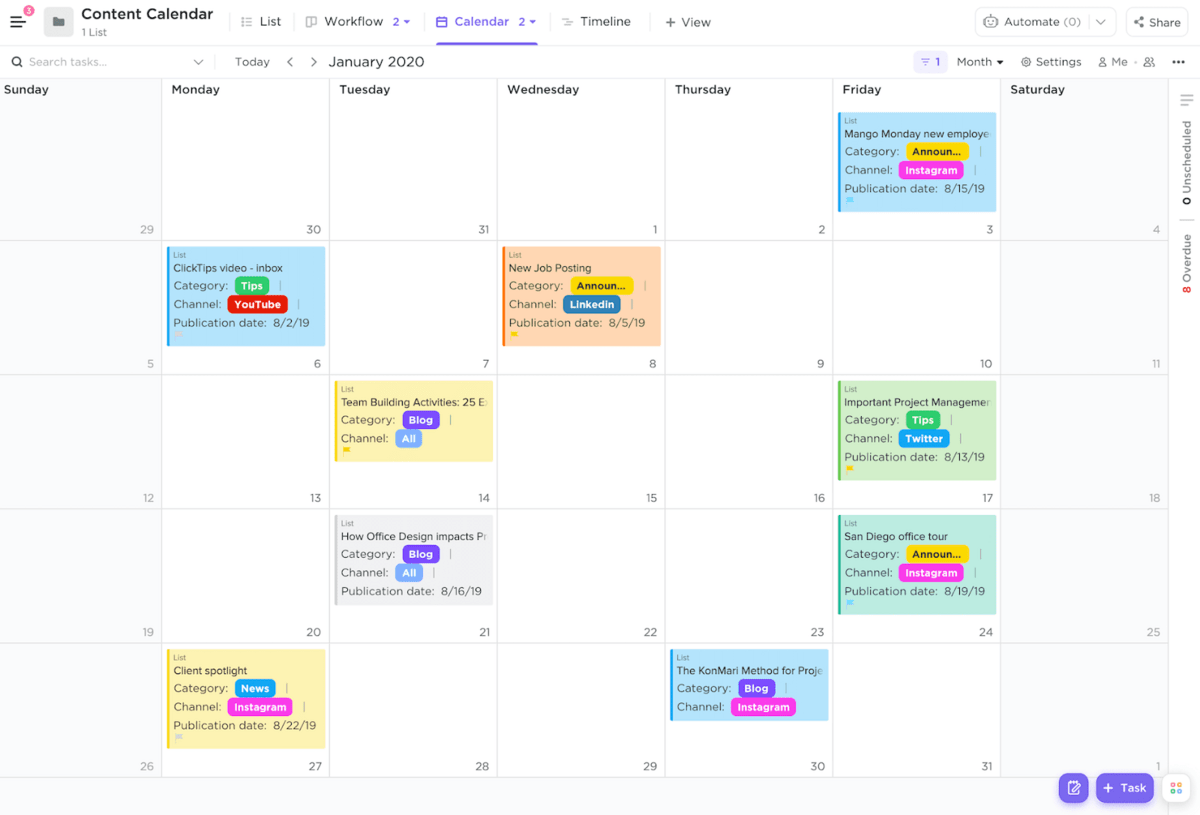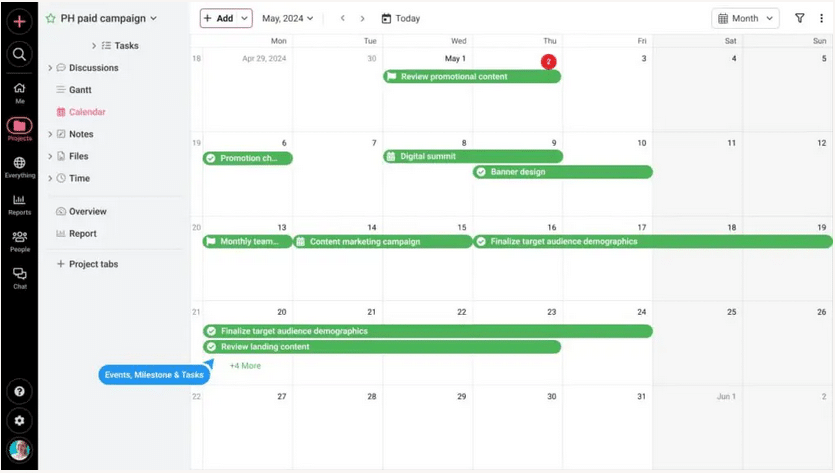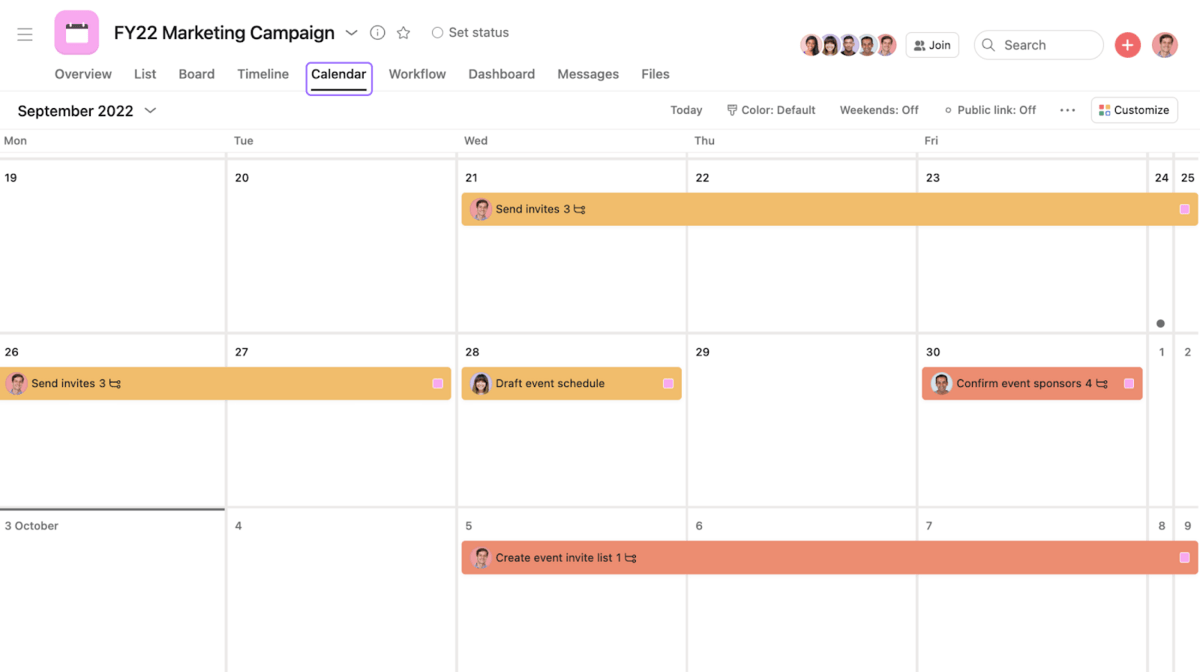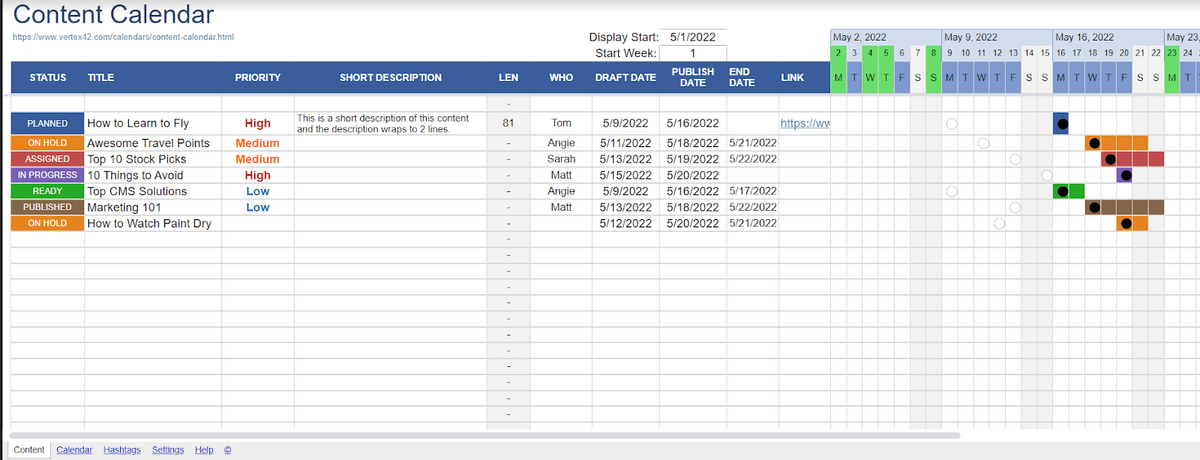
Have you heard the saying, “A chain is only as strong as its weakest link”? In content marketing, that link could be your content plan.
As a content marketer, you create and manage a lot of content, including blogs, emails, and social media posts. Without a plan in place, all that content can easily become chaos.
Even with excellent content ideas that appeal to your target audience, lacking a detailed content plan could result in poor execution. Yet, a Content Marketing Institute report suggests that only 40% of marketers had a documented content plan in 2022.
For seamless content operations, one tool that’s a must-have in your content marketing arsenal is an editorial calendar tool. It’s your weekly or monthly content plan.
An editorial content calendar tool can help marketing teams visualize and track everything.
Be it ongoing blog content projects or upcoming content, content marketing calendars make it easier for marketing team members to meet content deadlines and deliver on time.
We’ve compiled a list of the best editorial calendar tools and social media content calendars for organizing all types of content.
But before we get to that, here’s some basic information on editorial calendars.
Effortlessly export your Google Docs to WordPress with just 1-click.
Get Started Today
A content marketing editorial calendar is a timeline of all the content you plan to publish over a specific time, including project dates, assignees, task status, and deadlines.
Your content calendar must track all tasks, including new content, content audits, or content updates.
A good content calendar app helps keep all the content projects in a central location for easier access and organization.

Image provided by Narrato Team
Narrato Workspace is an AI content workflow platform. It brings several content planning, creation, optimization, and publishing tools under one roof. It has some cutting-edge AI content tools to help with content creation and optimization.
But if you’re looking for the perfect editorial calendar tool to track and manage all your content projects, Narrato can do that, too.
With Narrato, you can create a separate content calendar for each project. If you want an overview of all your content projects in a central location, it also has a Global Content Calendar.
And that’s not all. Narrato also lets you assign tasks, track content statuses, and manage your content workflow from the calendar view.
Here’s a look at the key features of this content calendar tool –
Narrato also offers Kanban Boards, which work the same way as the content calendar. Kanban boards allow you to track the status of all content tasks and move them from one workflow stage to another.
Another stellar content planning feature on Narrato Workspace is the AI Content Brief Generator. It generates SEO content briefs with keyword suggestions, questions/topics to include, and more.
And if you want to scale your content creation, you can also opt for their content writing service – Narrato Marketplace. Here you can get expert freelance writers for hire.
Pricing: Besides the free plan, Narrato Workspace provides Pro and Business plans, which start from $9 per user per month. There’s also a Custom plan to meet your unique content needs.

CoSchedule is an advanced marketing tool with robust content planning capabilities. The marketing editorial calendar provides clarity on all your content projects. It also makes assigning and rescheduling tasks a breeze.
Here are key content planning features of this editorial calendar tool –
CoSchedule can be a good choice for a content calendar tool, especially for social media managers in large organizations. But it does get a little complicated for content teams just getting started and isn’t as easy to use as some of the other tools on this list.
Pricing: The Free Forever plan provides all the basic content calendar capabilities. But if you want features like Recurring Tasks and Social Media Automation, you can use the Pro Marketing Calendar ($29 per monthly user).

The editorial content calendar in this project management tool is quite different. ClickUp gives you ready-to-use editorial calendar templates that you can edit and optimize for all types of content.
Some key content calendar planning capabilities provided in this tool are –
Besides the content calendar templates, ClickUp also has tables, Gantt charts, maps and mind maps, workload, etc.
Pricing: ClickUp provides five pricing plans. Free Forever, Unlimited, Business, Business Plus, and Enterprise. Content calendar templates are available in the free version. But for advanced capabilities, you can upgrade to paid plans, starting from $5 per monthly member.
SocialBee is a visual social media calendar for marketers, small business owners and entrepreneurs that helps them stay organized and plan strategically by offering a clear, centralized view of all scheduled content across platforms.
It acts as a control center for your content planning, making it easy to schedule, preview, and adjust posts without switching between tools or losing track of your publishing timeline.
SocialBee helps reduce the chaos of last-minute posting by giving you scheduling, platform-specific previews, and a full-picture view of your content strategy, ideal for content creators and marketing teams.
Key features include:
Pricing: SocialBee offers three paid plans to fit different needs: Bootstrap at $29/month, Accelerate at $49/month, and Pro at $99/month. You can explore all features with a free 14-day trial, no credit card required.

ProofHub is a project management and team collaboration software that provides you with “calendar” feature to manage content creation and distribution. It offers a centralized platform that brings clarity to what needs to be done, when, and by whom. You can create tasks or events for different content pieces like blog posts, newsletters, videos, social posts, ad campaigns etc. Moreover, you can also assign deadlines and categorize tasks by type, status, or channel to track progress in real-time.
ProofHub’s calendar feature will provide you with the following benefits:
Custom workflows:
You can create customized workflows, delegate tasks, and manage deadlines for every content marketing step with ProofHub.
Centralized location for storage:
All important files related to your marketing projects can be stored in one location for easy access and retrieval.
Built-in proofing tool:
The “Proofing” feature allows team members to review and provide real-time feedback. This specific feature helps in making necessary changes and ensuring the quality of your creative assets
Seamless collaboration:
Writers, editors, designers, and marketers can collaborate within tasks, adding comments, attaching drafts, and assigning subtasks. Also, they can use built-in chat to share instant feedback
Calendar integration:
ProofHub integrates with Outlook, iCal, and Google Calendar to offer a combined experience, even when different team members use different tools for calendars.
ProofHub also offers you Kanban boards and Gantt charts to help visualize task progress from one stage to another. It helps in making it easier to track how your editorial pipeline is moving.
Pricing: ProofHub offers a flat pricing model with no per-user fees.

Image provided by Narrato Team
Asana is another project management platform with an editorial calendar tool. It doesn’t specialize in content management, but it has various features that can help you with content planning and collaboration. The editorial content calendar on Asana can help teams collaborate better and stay on top of their content projects.
Integrating the Asana time tracker can further enhance workflow visibility by clearly showing the exact amount of time spent on each content task.
Asana’s editorial content calendar has the following capabilities –
Pricing: Besides the Basic plan, which is free, Asana also provides Premium and Business plans. The paid plans start from $10.99 per user per month. Note that the content calendar is available with the free version too.

Google Sheets is an indispensable tool for content planning. So much so that content teams often use it congruently with other content planning software. Why? For starters, it’s completely free, and if you’re working with other Google apps like Google Docs and Google Drive, it makes an entire ecosystem for you.
Also, the simple and intuitive interface makes it an accessible tool for all users. Be they inexperienced interns or tech-savvy content managers and social media marketers.
Google Sheets doesn’t have a dedicated editorial calendar feature, but you can use it to build your content calendar from scratch. If you don’t want to build a custom content calendar, you’ll find many free templates for Google Sheets on the web.
While it is an excellent tool for creating editorial content calendars, it does have some drawbacks –
Pricing: Free.
It’s clear from this list of tools given above that content calendar software can be very useful in the planning stage of the content marketing process. If you still aren’t convinced, here’s a look at all the benefits of using editorial content calendar tools
When it comes to efficient content planning and execution, organizing is everything. If you aren’t organized during the planning process, keeping on top of all your deadlines, goals, and objectives will get difficult.
Things get even more complicated when using different content formats in your content marketing efforts. A content calendar, along with a content brief, makes this organization a little bit easier. It provides a visual overview of your content plan for a month/week.
A content calendar provides a fresh viewpoint for how you see your content. It allows you to step back and assess the complete picture, covering blog posts, social media posts, or anything else.
An editorial calendar makes the identification of content gaps easier, allowing you to leverage any opportunities for improvement. Without this big-picture perspective, it’s easy to get caught up in the details of content creation.
Kapost’s research has found that almost 36% of organizations miss content deadlines when they don’t have a centralized editorial content calendar. An editorial content calendar makes it easy to check the progress of content tasks and stay updated on who is working on which task.
When you know how your content projects are progressing, you can ensure that all the team members stay on track and guide those falling behind.
It also increases transparency and accountability.
Most content creators prefer to work ahead of time on their content tasks to ensure that they have enough time for content publishing and content optimization. An editorial content calendar makes this easier.
When you can spot which content tasks are coming up, you’ll be able to manage your schedule better.
There’s usually a lot of back and forth involved in content creation and collaboration between the content writers, editors, and other stakeholders. When so many people are involved in the same task, it can result in chaos.
A content calendar can be a godsend here, making the content processes more efficient and the entire content workflow more streamlined.
When paired with the right tools for project management, the streamlining becomes even more powerful by helping teams coordinate tasks, track progress, and collaborate with both internal and external stakeholders seamlessly.
This covers everything you need to know about content calendar tools. Do you feel spoiled for choice? Here are some things to consider before you make a final choice –
There’s no shortage of options when it comes to editorial calendar tools. With these tips and the excellent list of editorial calendar tools, we hope we’ve made the choice a little easier for you.